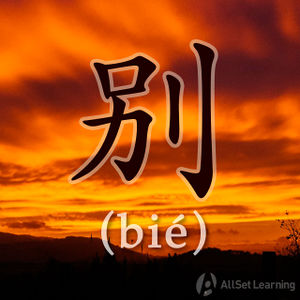Difference between revisions of "Negative commands with "bie""
m (Text replacement - "{{HSK|HSK2}}" to "{{HSK|HSK2}}{{2021-HSK|HSK2}}") |
|||
| (14 intermediate revisions by 5 users not shown) | |||
| Line 3: | Line 3: | ||
Instead of saying "do not" with [[Negative commands with "bu yao"|不要 (bùyào)]], we can say "don't" a little more quickly and forcefully by using 别 (bié). | Instead of saying "do not" with [[Negative commands with "bu yao"|不要 (bùyào)]], we can say "don't" a little more quickly and forcefully by using 别 (bié). | ||
| − | + | == Structure == | |
| − | + | Besides using [[Negative commands with "bu yao"|不要 (bùyào)]], negative commands can also be formed with 别 (bié). You could think of 别 (bié) as a contraction of 不要 (bùyào), as the structure is the same for both: | |
<div class="jiegou"> | <div class="jiegou"> | ||
| − | 别 + Verb + | + | 别 + Verb (+ Obj.) |
</div> | </div> | ||
| − | + | == Examples == | |
<div class="liju"> | <div class="liju"> | ||
| − | * <em>别</em> 走。<span class="pinyin">< | + | *<em>别</em> 走。<span class="pinyin"><em>Bié</em> zǒu.</span><span class="trans">Don't leave.</span> |
| − | * <em>别</em> 说话!<span class="pinyin">< | + | *<em>别</em> 说话!<span class="pinyin"><em>Bié</em> shuōhuà! </span><span class="trans">Don't speak! </span> |
| − | * <em>别</em> 笑!<span class="pinyin">< | + | *<em>别</em> 笑!<span class="pinyin"><em>Bié</em> xiào! </span><span class="trans">Don't laugh! </span> |
| − | * <em>别</em> 动!<span class="pinyin">< | + | *<em>别</em> 动!<span class="pinyin"><em>Bié</em> dòng!</span><span class="trans">Don't move!</span> |
| − | * <em>别</em> 过来!<span class="pinyin"><em>Bié</em> guòlái! </span><span class="trans">Don't come over here! </span> | + | *<em>别</em> 过来!<span class="pinyin"><em>Bié</em> guòlái! </span><span class="trans">Don't come over here! </span> |
| − | * <em>别</em> 打 孩子!<span class="pinyin">< | + | *<em>别</em> 打 孩子!<span class="pinyin"><em>Bié</em> dǎ háizi!</span><span class="trans">Don't hit the child!</span> |
| − | * <em>别</em> 喝 太 多。<span class="pinyin">< | + | *<em>别</em> 喝 太 多。<span class="pinyin"><em>Bié</em> hē tài duō.</span><span class="trans">Don't drink too much.</span> |
| − | * | + | *喝酒 以后 <em>别</em> 开车。<span class="pinyin">Hējiǔ yǐhòu <em>bié</em> kāichē.</span><span class="trans">After drinking alcohol, don't drive.</span> |
| − | * 吃饭 的 时候 <em>别</em> | + | *吃饭 的 时候 <em>别</em> 玩 手机。<span class="pinyin">Chīfàn de shíhou <em>bié</em> wán shǒujī.</span><span class="trans">When eating, don't play with your cell phone.</span> |
| − | * 上课 的 时候 <em>别</em> 说 英文。<span class="pinyin">Shàngkè de shíhou < | + | *上课 的 时候 <em>别</em> 说 英文。<span class="pinyin">Shàngkè de shíhou <em>bié</em> shuō Yīngwén.</span><span class="trans">Don't speak English in class.</span> |
</div> | </div> | ||
| Line 33: | Line 33: | ||
* [[Negative commands with "bu yao"]] | * [[Negative commands with "bu yao"]] | ||
| + | * [[Expressing "don't need to" with "buyong"]] | ||
== Sources and Further Reading == | == Sources and Further Reading == | ||
| Line 42: | Line 43: | ||
=== Books === | === Books === | ||
| − | + | {{Source|Integrated Chinese: Level 1, Part 1 (3rd ed)|155}} | |
| − | + | {{Source|Modern Mandarin Chinese Grammar: A Practical Guide|325}} | |
| − | + | {{Source|A Practical Chinese Grammar For Foreigners (外国人实用汉语语法)|46-47}} | |
[[Category:A2 grammar points]] | [[Category:A2 grammar points]] | ||
| + | {{HSK|HSK2}}{{2021-HSK|HSK2}} | ||
{{Used for|Giving commands}} | {{Used for|Giving commands}} | ||
{{Used for|Denying and refusing}} | {{Used for|Denying and refusing}} | ||
{{Basic Grammar|别|A2|别 + Verb|<em>别</em>走。|grammar point|ASG9W0UX}} | {{Basic Grammar|别|A2|别 + Verb|<em>别</em>走。|grammar point|ASG9W0UX}} | ||
| − | {{Similar|Negative commands with " | + | {{Similar|Negative commands with "buyao"}} |
| + | {{Similar|Expressing "don't need to" with "buyong"}} | ||
{{POS|Adverbs}} | {{POS|Adverbs}} | ||
{{Translation|don't}} | {{Translation|don't}} | ||
Latest revision as of 08:53, 21 April 2021
-
Level
-
Similar to
-
Used for
-
Keywords
Instead of saying "do not" with 不要 (bùyào), we can say "don't" a little more quickly and forcefully by using 别 (bié).
Structure
Besides using 不要 (bùyào), negative commands can also be formed with 别 (bié). You could think of 别 (bié) as a contraction of 不要 (bùyào), as the structure is the same for both:
别 + Verb (+ Obj.)
Examples
- 别 走。Don't leave.
- 别 说话!Don't speak!
- 别 笑!Don't laugh!
- 别 动!Don't move!
- 别 过来!Don't come over here!
- 别 打 孩子!Don't hit the child!
- 别 喝 太 多。Don't drink too much.
- 喝酒 以后 别 开车。After drinking alcohol, don't drive.
- 吃饭 的 时候 别 玩 手机。When eating, don't play with your cell phone.
- 上课 的 时候 别 说 英文。Don't speak English in class.
See also
Sources and Further Reading
Videos
- Yoyo Chinese: Negative commands



